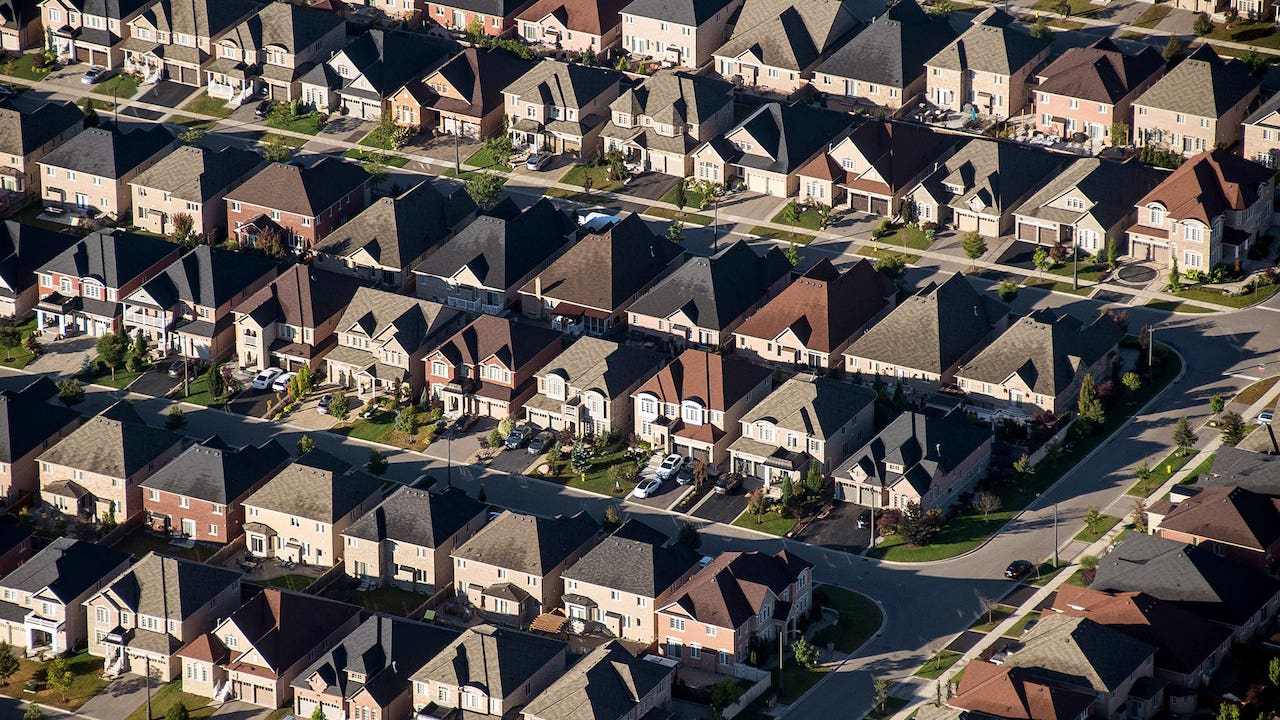It’s the end of an era for mortgage rates

The Bankrate promise
At Bankrate we strive to help you make smarter financial decisions. While we adhere to strict , this post may contain references to products from our partners. Here's an explanation for .
For two decades, American homeowners enjoyed historically cheap mortgages. Rates on home loans ranged from low to ridiculously low.
Let’s take a trip down memory lane: From April 20, 2011, through Oct. 3, 2018, the average 30-year mortgage rate never topped 5 percent. After an eight-week period of mortgage rates barely above 5 percent in the fall of 2018, rates plunged again, falling below 3 percent during the depths of the pandemic. It wasn’t until April 2022 that they rose above 5 percent again. To put it another way, throughout an 11-year period, the typical mortgage rate ticked above 5 percent for all of two months.
Now, though, amid an aggressive inflation-fighting policy from the central bank, rates have roared back. They hit 7.31 percent in Bankrate’s latest national survey of lenders — a 22-year high.
The end of an era
“The Federal Reserve has closed the door on the era of super-low interest rates over the past year and a half,” says George Ratiu, chief economist at Keeping Current Matters, a real estate data firm.
That new reality has jolted the housing market: Home sales have fallen sharply since 2021, and homeowners, reluctant to give up their super-low locked-in mortgage rates, have staged a “seller’s strike.” Housing affordability has emerged as a persistent challenge.
“The punchbowl of lower rates has been taken away,” says Mark Hamrick, Bankrate’s senior economic analyst. “That has inflicted a sobering environment on the housing market.”
The punchbowl of lower rates has been taken away. That has inflicted a sobering environment on the housing market.— Mark Hamrick, Bankrate senior economic analyst
The last time U.S. mortgage rates topped 7.3 percent, in May 2001, the U.S. economy was in a very different place. The median home price was a quaint $156,000, according to the National Association of Home Builders/Wells Fargo affordability index, and the typical family income was a modest $52,500. Facebook didn’t yet exist, Big Tech was in its infancy and Alan Greenspan presided over the Federal Reserve as the revered master of financial markets.
Now, more than two decades on, mortgage rates have again breached the 7.3 percent threshold. Much has changed in the meantime. The price of the typical U.S. home is nearly $400,000, and median family incomes are flirting with six figures. Big Tech drives the U.S. economy, and Greenspan’s reputation as a genius took a hit when the financial crisis of 2008 erupted.
What kicked off the era of super-low rates?
While today’s borrowers have been conditioned to consider low mortgage rates a birthright, the reality is that rates have, at times, been much higher than they are now. Mortgage rates topped 18 percent in 1981, the bad old days of stagflation, and they stayed stubbornly high throughout the 1980s.
“There’s no doubt that we’ve been spoiled to some degree by record low or low interest rates over the years going back to the Great Financial Crisis,” Hamrick says. “The reality is that mortgage rates have settled into a range that’s more in line with modern history.”
In May 2001, a mortgage rate above 7 percent seemed perfectly ordinary. Then history happened. September 11 brought the U.S. economy to a standstill. The attacks startled Greenspan, the Fed chairman widely lauded for guiding the U.S. economy through the boom years of the 1990s. While Greenspan publicly exuded calm in the days after 9/11, he later acknowledged that he privately dreaded more attacks that would cripple the economy — and that his fear spurred him to slash interest rates and to keep them low.
When Greenspan’s post-retirement autobiography was published in 2007, he made the surprising admission that his low-rate policy reflected his assumption that terrorists would cause further devastation. “Like most people in government, I fully expected more attacks,” Greenspan wrote in “The Age of Turbulence.”
The U.S. economy was in a minor recession after the tech bubble burst earlier in 2001, but Sept. 11 raised the stakes. To Greenspan, another terrorist attack would be economically devastating, and he viewed low rates as a shock absorber that could soften the jolt of a second assault.
The terror threat was just one source of volatility. The attacks spawned wars in Iraq and Afghanistan. A wave of corporate scandals sent shares of high-flying companies Enron, WorldCom and Tyco plummeting.
“The Fed’s response to all this uncertainty was to maintain our program of aggressively lowering short-term interest rates,” Greenspan wrote in his autobiography.
To be clear, the central bank doesn’t control mortgage rates directly. But the Fed does set the overall tone — and for two decades, it cut rates aggressively and raised them reluctantly. The post-9/11 rate cuts set the stage for the U.S. housing bubble, which in turn led to the Great Recession.
“The Fed dropped the funds rate from 6.5 percent in December 2000 to 1.8 percent in the span of just 12 months, ultimately pushing it down to 1.0 percent by August 2003,” Ratiu says. “Many economists view that period as partly responsible for the asset bubble of the mid-2000s, which led to the housing crash and financial crisis of 2008.”
Slow growth after the Great Recession led the Fed to keep rates low. Then, when the COVID pandemic hit in 2020, the Fed slashed rates all the way to zero. Mortgage rates followed, dipping as low as 2.93 percent in Bankrate’s survey. It wasn’t until inflation surged that the Fed reversed course. The central bank has raised rates 11 times in 2022 and 2023, and mortgage rates have followed.
Some experts still optimistic: ‘Rates will come down’
Not everyone is writing the obituary for low mortgage rates, however. While no one thinks they will plunge back to 3 percent in the near future, some housing economists see a retreat on the horizon. The Mortgage Bankers Association, for example, predicts 30-year mortgage rates will fall to 5.9 percent by late 2023, and to 4.9 percent by late 2024.
“Rates will come down, though we will not see super-low rates soon,” says Susan Wachter, a housing economist at the University of Pennsylvania’s Wharton School. “But if we shift from inflation to disinflation with slow growth, do not rule them out. China is moving toward low rates now.”
Lisa Sturtevant, chief economist at Bright MLS, a listing service in the mid-Atlantic region, points to the “mortgage spread” as a reason for optimism. The term refers to the gap between 30-year mortgage rates and their closest proxy, 10-year Treasury yields. While the spread historically is less than 2 percentage points, the gap has been 3 percentage points for much of 2023.
“There is potential good news about where mortgage rates might be headed,” Sturtevant says. “The gap between the 10-year Treasury yield and the 30-year fixed-rate mortgage rate is still very wide.”
Sturtevant and other housing economists say a return to normal spreads would ease some of the pain for rising mortgage rates.
“Treasury yields are at about 4.2 percent, which means that if the gap returned to historic norms, mortgage rates should be about 6.2 percent, nearly a full percentage point lower than where they are today,” she says.
High-rate tips for homebuyers
High rates are challenging for homebuyers, but it’s worth noting that millions of Americans bought homes before the recent era of super-low rates. From late 1978 through late 1990, mortgage rates averaged more than 12 percent, and they dipped into the single digits only on rare occasions. Buyers still found ways to get deals done.
“The silver lining for housing through the first seven months of 2023 is that many buyers are seeing current rates as the new normal,” Ratiu says.
Of course, it’s not easy to buy a house when rates are at generational highs. Here are some ways to cope:
- Budget astutely: Even with the surge in mortgage rates, home values remain near all-time highs. That means you might have to tighten your budget, perhaps by buying a home that is smaller than you’d like, needs some work or is located in an up-and-coming neighborhood.
- Curate your credit score: Your credit score is the single most important factor in determining your mortgage rate, so make sure it’s as high as you can get it. The higher your score, the lower the rate you’ll qualify for.
- Shop around for a mortgage deal: You can save thousands of dollars over the life of the loan by comparing quotes from at least three lenders. Comparison-shopping for a mortgage is always a good idea, but the benefits grow during volatile rate environments, according to research by Freddie Mac.
- Negotiate for a rate buydown: Some sellers have begun paying for rate buydowns, an incentive that sweetens the deal for buyers. It couldn’t hurt to ask.
Related Articles



